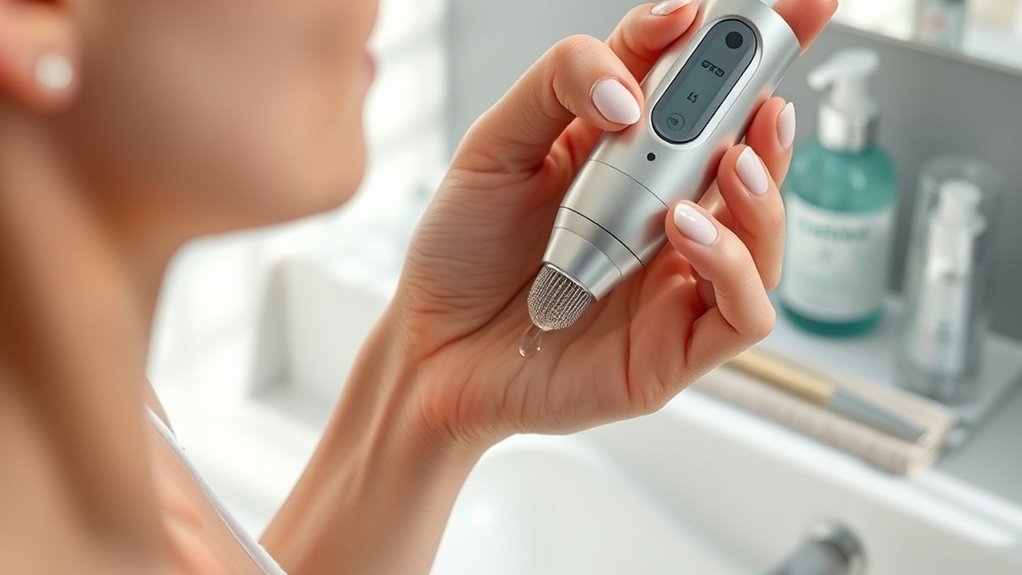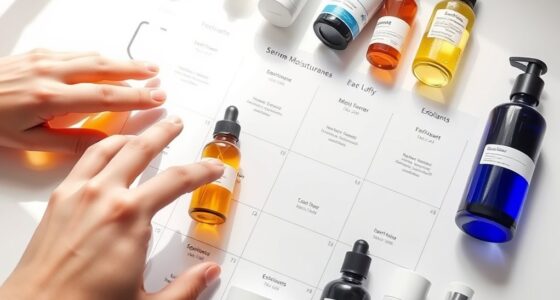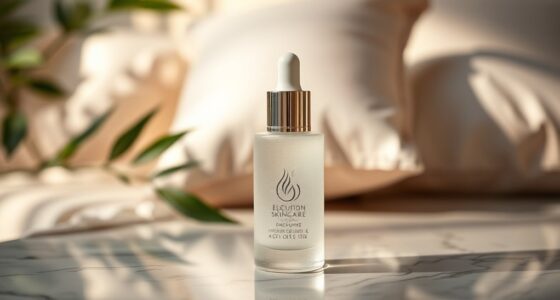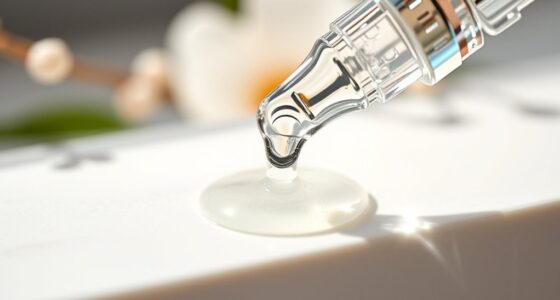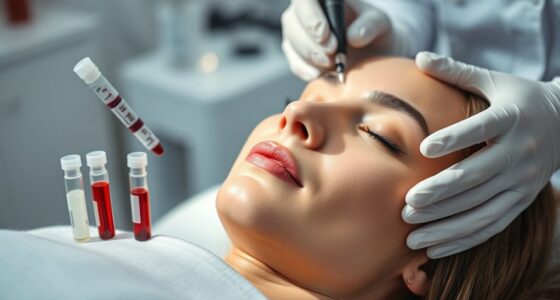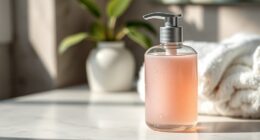Before starting at-home microneedling, see a dermatologist to guarantee it’s safe for your skin type and concerns. Use sterilized or single-use tools, clean your skin thoroughly, and follow proper techniques with gentle pressure. Avoid overdoing sessions and give your skin time to heal between treatments. Afterward, moisturize, use sun protection, and skip harsh products. Following these safety tips helps minimize risks and boosts results—if you’re curious, there’s more to discover below.
Key Takeaways
- Consult a dermatologist first to assess skin suitability and receive personalized guidance before starting at-home microneedling.
- Use sterilized or single-use tools and maintain a clean environment to prevent infections.
- Follow proper technique, including gentle pressure and correct needle depth, to minimize skin trauma.
- Avoid overuse and follow recommended session intervals to prevent irritation and scarring.
- Post-treatment, apply recommended serums, protect skin from sun, and avoid harsh products to support healing and optimal results.

Microneedling at home has become an increasingly popular way to improve skin texture and promote a youthful glow without visiting a dermatologist. While DIY microneedling can be effective, it’s essential to prioritize safety from the start. Before you begin, scheduling a dermatologist consultation is highly recommended. A dermatologist can assess your skin type, identify any underlying conditions, and advise whether microneedling is suitable for you. They might also recommend specific products or techniques tailored to your skin’s needs. This step helps you avoid potential adverse reactions and guarantees that you approach the process with proper guidance.
Consult a dermatologist before starting at-home microneedling for personalized skin guidance.
Once you’re cleared by a professional, the next vital aspect is product sterilization. Proper sterilization of your microneedling device is vital to prevent infections or skin irritations. Always choose a device that can be thoroughly sterilized or is single-use. Before each session, clean your device with alcohol or an approved disinfectant, following the manufacturer’s instructions carefully. Never share your microneedling tools with others, as this can transfer bacteria and cause complications. Maintaining a sterile environment minimizes the risk of infections and promotes better healing and results.
When preparing your skin, wash your face thoroughly with a gentle cleanser to remove oils, dirt, and makeup. Apply a numbing cream if necessary, but only as directed, to avoid over-application. Before starting, ensure your hands are clean, and your workspace is sanitized. During the procedure, you should gently roll or press the device onto your skin, applying even pressure without forcing it. Overusing or pressing too hard can cause unnecessary trauma. Follow the recommended needle depth and frequency—usually once every few weeks—to give your skin time to recover. Overdoing it can lead to irritation, redness, or even scarring.
Post-treatment care is equally significant. After microneedling, your skin will be more receptive to serums and moisturizers, so apply products recommended by your dermatologist. Use soothing, hydrating ingredients like hyaluronic acid and avoid harsh chemicals or irritants. Keep your skin protected from the sun by applying broad-spectrum sunscreen daily. This helps prevent pigmentation issues and supports healing. Also, avoid picking at your skin or using harsh scrubs during recovery.
Frequently Asked Questions
Can I Use Microneedling Devices on Sensitive Skin Types?
Yes, you can use microneedling devices on sensitive skin types, but you need to be cautious. Choose a device with adjustable settings to minimize irritation and always start with the lowest intensity. Pay attention to your skin’s response, and avoid aggressive treatments. It’s also essential to select a device compatible with sensitive skin to reduce the risk of adverse reactions, and consider consulting a dermatologist for personalized advice.
How Often Should I Replace the Microneedling Cartridge or Needle Head?
Think of your microneedling device as a trusty paintbrush that needs fresh bristles to work its magic. You should replace the cartridge or needle head after about 5 to 10 uses, depending on the manufacturer’s guidelines. Keep an eye on the cartridge lifespan and follow the needle replacement schedule to guarantee safety and the best results. Regular replacements help prevent infections and maintain effective treatment, like tending to a well-loved tool.
Are There Specific Skin Conditions That Contraindicate At-Home Microneedling?
You should avoid at-home microneedling if you have dermatological contraindications like active infections, eczema, psoriasis, or severe acne, as these skin condition considerations can worsen your skin or cause complications. If you’re pregnant, nursing, or have a history of keloid scars, consult your dermatologist first. Always evaluate your skin’s health before starting, and stop if you notice irritation or adverse reactions to ensure safety and effective results.
What Are the Signs of an Adverse Reaction Post-Microneedling?
After microneedling, watch for signs of adverse reactions. If you notice allergic reactions like rash, itching, or swelling, stop use immediately. Infection signs such as increased redness, pus, or warmth around the treated area also indicate a problem. If these symptoms occur, consult a healthcare professional promptly. Always follow aftercare instructions to minimize risks and ensure proper healing after your microneedling session.
Can I Combine Microneedling With Other At-Home Skincare Treatments?
You can combine microneedling with other at-home skincare treatments, but you should approach it carefully. Combining treatments can enhance skincare synergy, leading to better results, but it also increases the risk of irritation. Always wait a few days between treatments, and consult a skincare professional to guarantee safe combinations. Avoid using harsh ingredients immediately after microneedling, and listen to your skin’s response to prevent adverse reactions.
Conclusion
By understanding the safety precautions, following proper techniques, and setting realistic expectations, you can confidently pursue microneedling at home. Embrace the process, respect your skin’s response, and prioritize cleanliness and patience. With consistent care, you’ll improve your skin’s texture, boost your confidence, and achieve a healthier glow. Remember, dedication, caution, and persistence are your keys to success—because when you care for your skin properly, you empower your confidence, your beauty, and your well-being.
